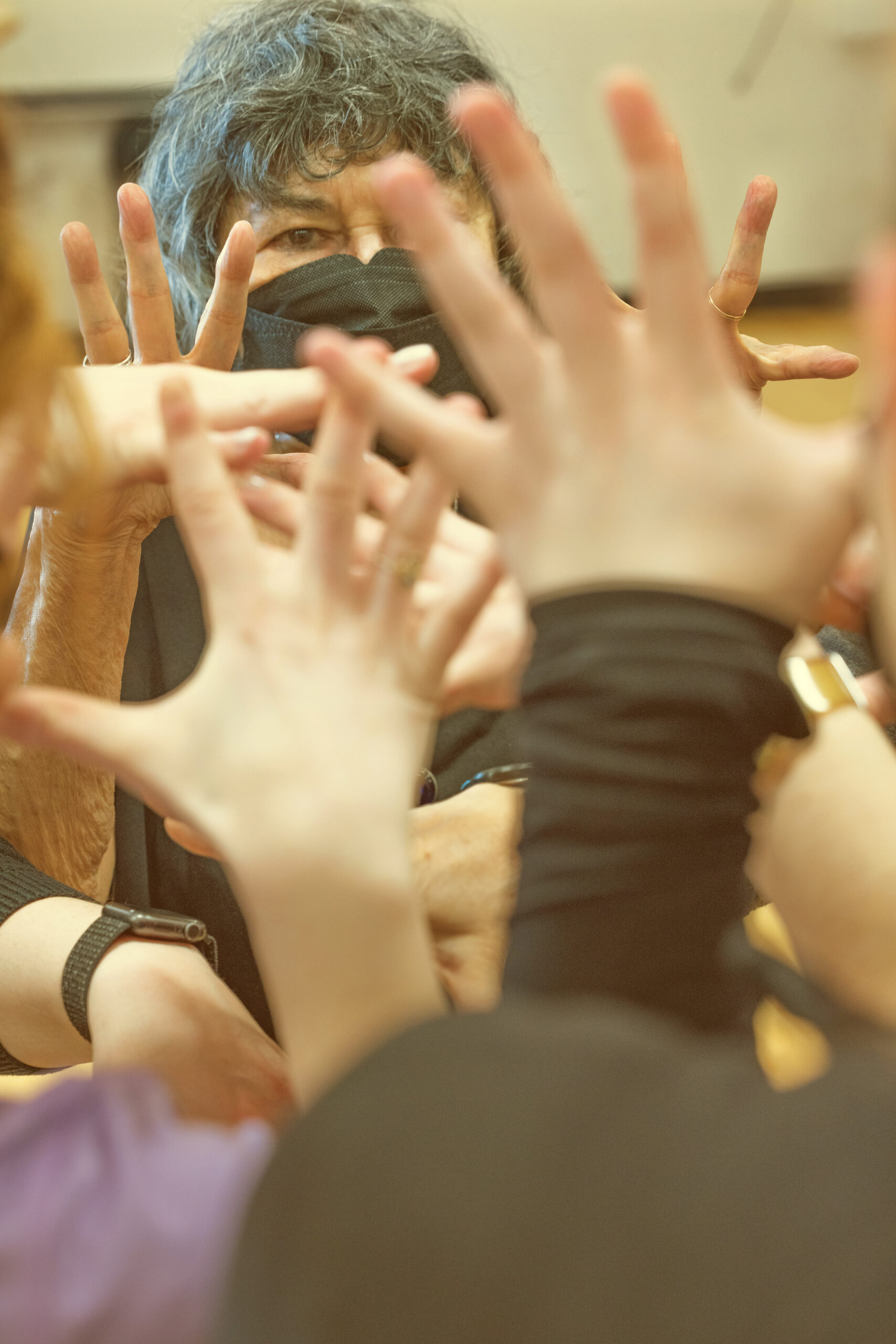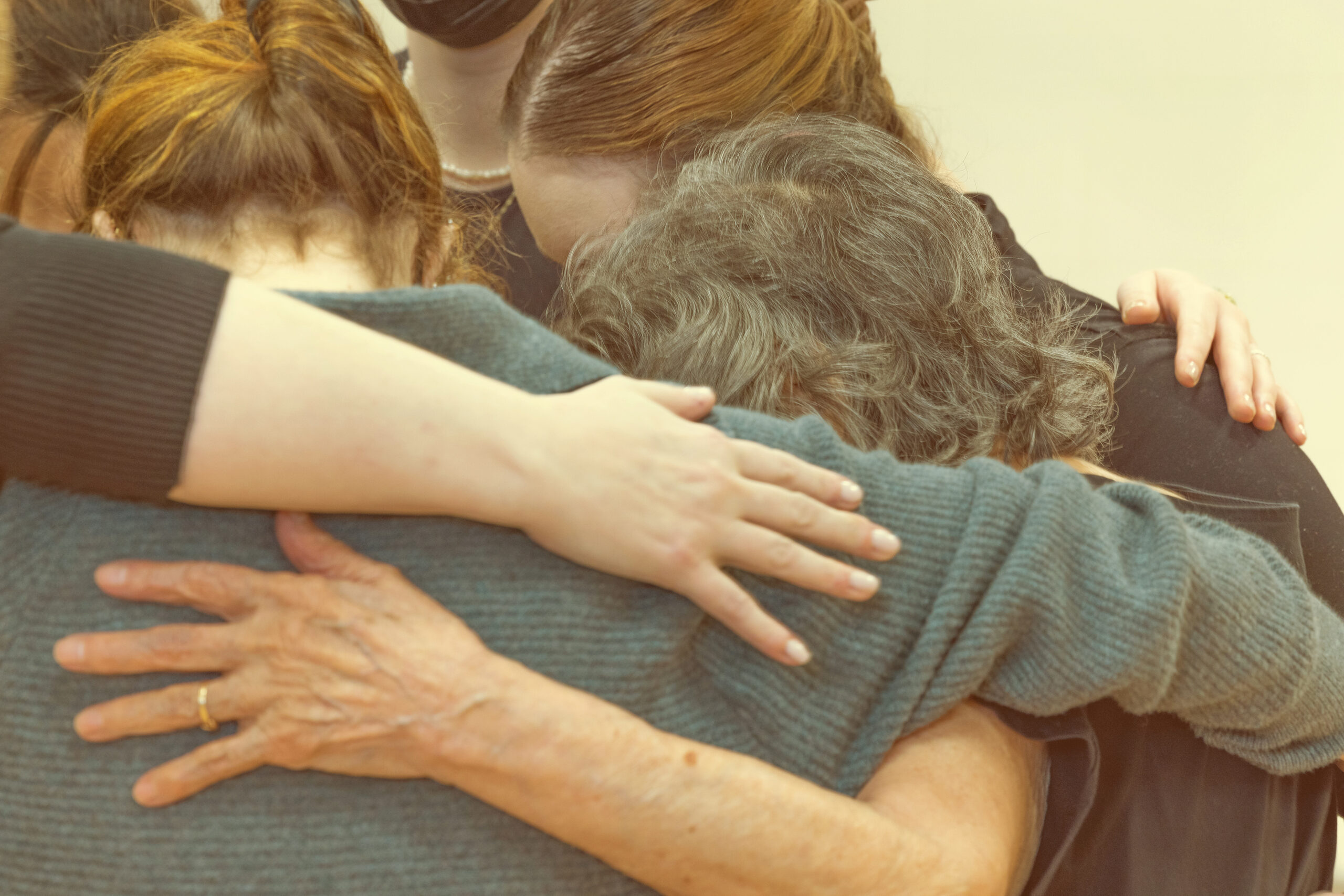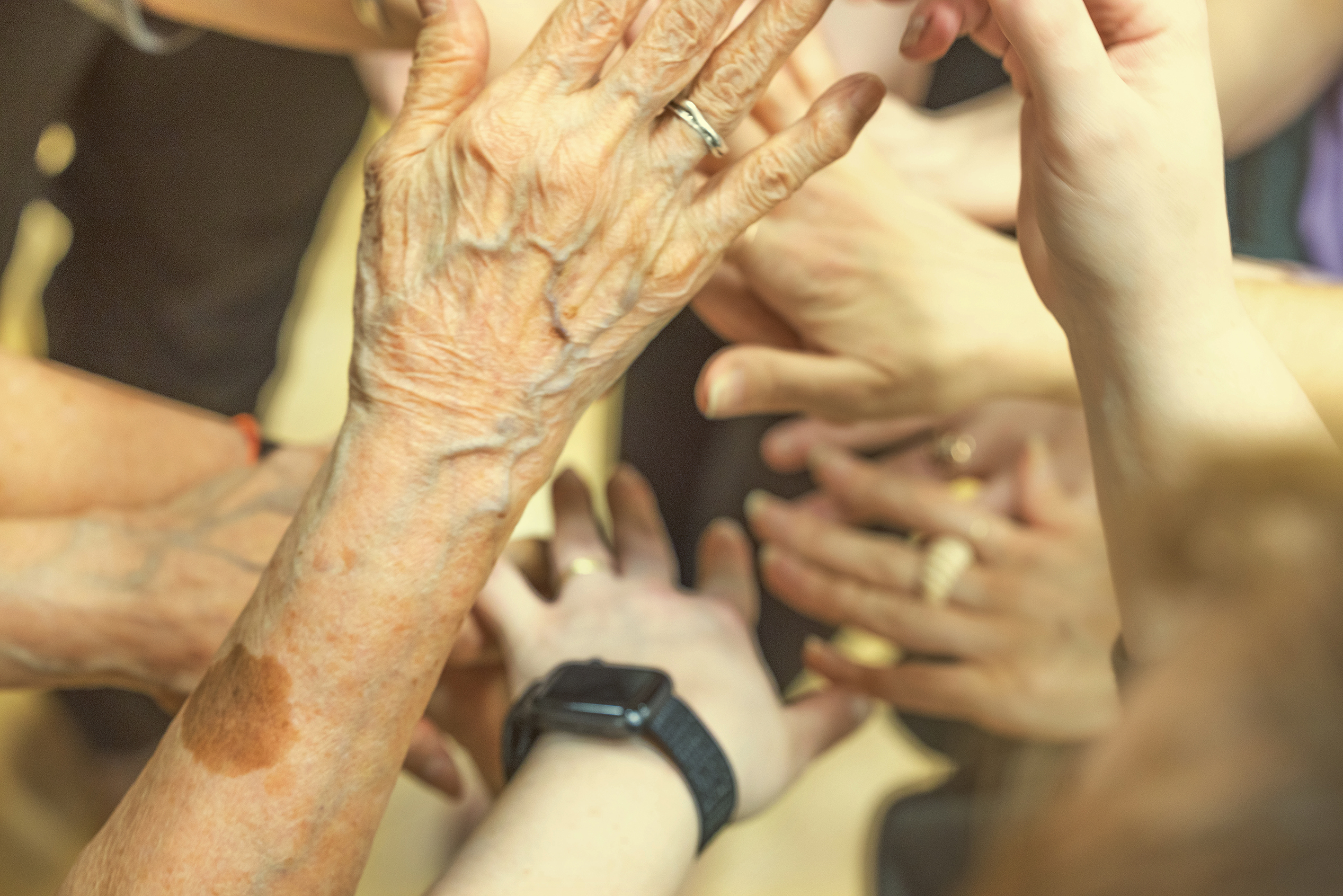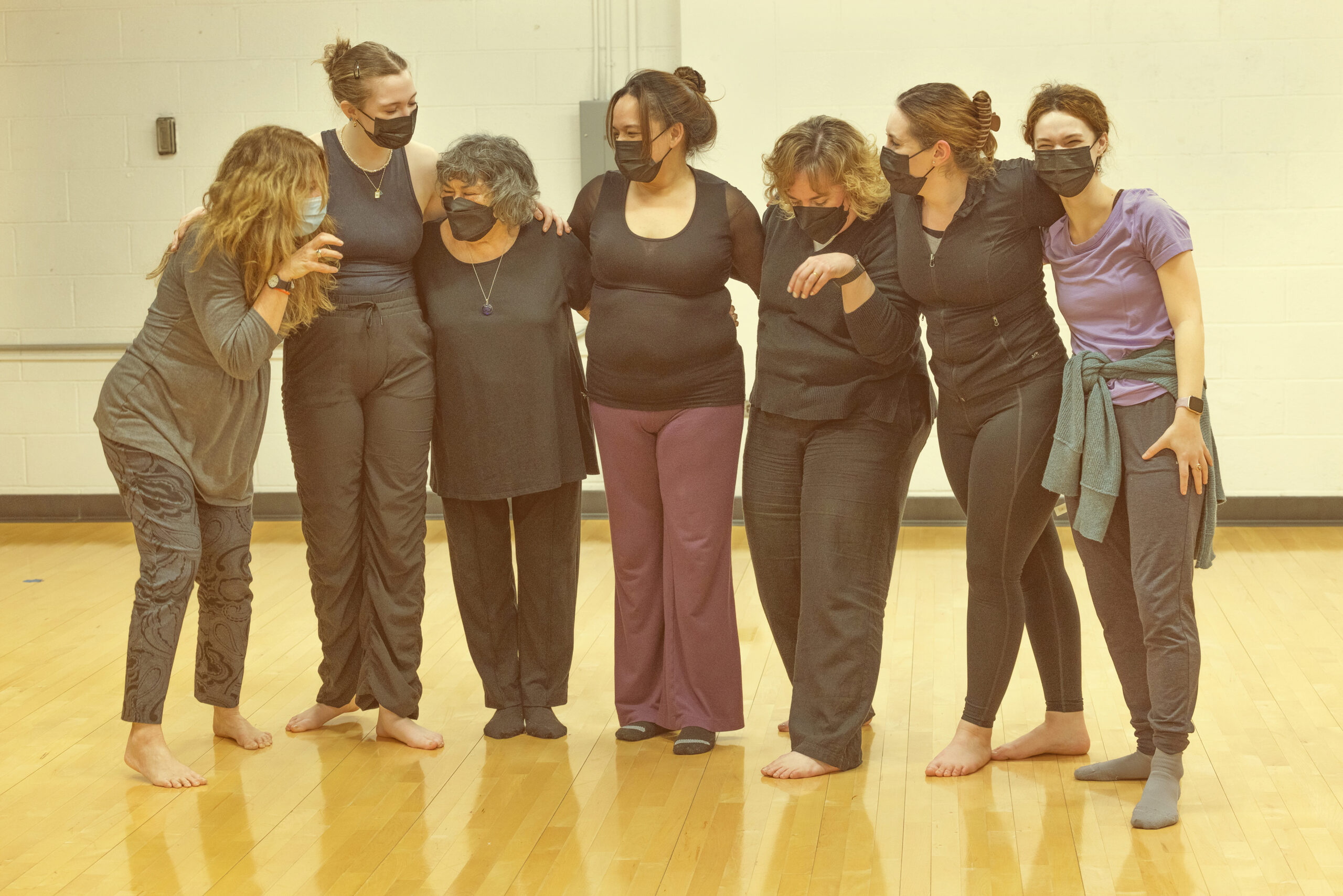In a warmly lit space, laughter is in the air as the first ethereal strains of Grover Washington Jr.’s “Just the Two of Us” emanate from a record player. People begin to move through the room, though some are slow to rise from their seats along one of the walls.
“Would you care to join me?” asks Elissa Queyquep White, extending a hand to a seated man at the end of the row. “Come on in.”
The 12 participants in this videotaped dance therapy session, held as part of a day treatment program at a clinic in New York’s Westchester County in 1986, settle into a cadence of steps on the beat, shifting side to side, focusing on the motion of their feet. White, a dance therapist, moves along with them, picking up nuances in their movements and adding them to her own, encouraging them to add in a twist, then a snap, then open up the space around them with arms floating outward. They connect eyes and reach out to one another, link hands and rotate heads and shoulders in circles, each movement slowly built on top of the last, all to the rhythm of the music. By the last saxophone solo, they have arrived in a state of being different from the one in which they had started.
The rhythmic movements have prepared the participants, or patients, to move as members of a group, to establish trust, and offer the therapist, in this case White, a chance to assess where each of them is emotionally. As the recorded clinical session progresses, with White’s guidance, participants touch hands and shoulders, lean against one another to feel resistance and their weight in space, and slowly break away.
This therapeutic practice is built on the premise that movement can unlock patients’ connection to their physical state of being—their height, width, strengths, and sensitivities—and allow them to experience feelings in a more expansive way. It draws on dance’s expressive potential and taps into “the spirit of being human” as White, one of the defining figures of the dance therapy field who has been on the faculty of the Dance/Movement Therapy Program at Pratt Institute since 2004, put it in a conversation at Pratt last fall.

White began her career as a dance therapist and dance therapy educator in the 1960s, following a career in dance performance that extended back to her childhood. At that time, dance therapy existed as a discrete practice within psychotherapy that had been growing in demand within psychiatric institutions but did not yet have an organized professional structure around it. Along with fellow practitioner Claire Schmais and psychologist Martha Davis, White established the first master’s program in dance/movement therapy, at Hunter College in New York City, developing a curriculum shaped by their clinical experience in dance therapy and research and education around the movement of the body in relation to the mind, combined with a shared commitment to using dance in service of others. White, Schmais, and a handful of fellow practitioners from across the country also established the American Dance Therapy Association (ADTA), in 1966, and White would go on to serve as ADTA president from 2002 to 2006.
Having taught a number of Pratt alumni who have gone on to join the faculty as well as Chair of Creative Arts Therapy Valerie Hubbs, White’s influence at Pratt runs deep, connecting current and future practitioners and educators to the foundations of their field. Erin Holmes, MS Dance/Movement Therapy ’10, visiting instructor for the Advanced Seminar I & II in Dance/Movement Therapy at Pratt, calls White her godmother, and shared in a conversation last fall that many others do the same.
Cheryl Clark, MS Dance/Movement Therapy ’19, visiting instructor of Studies in Movement Behavior I & II at Pratt, expressed a similar sentiment, and reflected on the depth of perspective White brings to her students. “Elissa Queyquep White is a living treasure,” Clark wrote in an email. “Elissa is one of those links to the primary source. Elissa herself, in writings, acknowledged the fact that throughout history, dance has been used to mark significant aspects of the life cycle. . . . What appears to have changed is the attitudes of the practitioners of mind in the West, who began to wake up and see that the body was as key to expression as words were. This places Elissa at a very important moment in the development of the field.”
Primary Source
While, as a result of White and her colleagues’ efforts, the profession gained an organizing structure in the mid-1960s, the roots of dance therapy practice go back further, with several individuals developing methods for using dance as healing in the early to mid-20th century. These practices were birthed out of modern dance, with its focus on “dance as a means of expression of human events,” as White described it in a 2004 interview in American Journal of Dance Therapy (AJDT). Their deeper lineage dates back to prehistory, in communities’ use of rhythmic movement to bring one another together at moments of significance: “Throughout history, people have expressed themselves through moving together to a common rhythm,” White and Schmais wrote in a 1970 article, “Introduction to Dance Therapy,” published by the Congress on Research in Dance and later republished in AJDT.
Several of those early practitioners served as mentors to White and her fellow ADTA founders, forerunners including Mary Whitehouse and Alma Hawkins in California, Liljan Espenak, Elizabeth Polk, and Blanche Evan in New York, and, in Washington, DC, Marian Chace, widely recognized as the originator of dance therapy as a formalized practice. A trained dancer—who was part of Denishawn Dance Company, the trailblazing modern dance troupe—and then dance instructor who shifted her focus from the dance technique to the dancing person, Chace was asked to “teach” patients at St. Elizabeth’s Hospital in Washington, DC, and that teaching resulted in the formation of the first dance therapy program, in the 1940s. Chace would go on to be one of White’s principal influences. It was with Chace’s blessing that the ADTA was established, and she became the ADTA’s first president.
The ADTA was a means of bringing those disparate practices into conversation. “We all felt that we needed to talk about what we were doing,” White said, emphasizing that it was about more than bringing unity to a profession. “Most of us were involved in civil rights. We understood what a cause was, and we understood how important it was to talk to each other.” (White’s own parents were politically active union organizers who instilled her with the value that “your life had to do with . . . making sure other people had a life,” as she said in the AJDT interview.)
The shared vision of the ADTA founders: “To conquer the world with dance therapy!” White said, with her characteristic humor. But in earnestness, it was about creating change from a place of movement, and making space for patients to be people in a social context that doesn’t often support that notion. “Our society wants patients to be different, instead of helping them be who they are.”
Their mission, White explained, would come with its share of challenges: “It took us a long time to understand that dance in our society holds a very specific, rigid place—like performance. When we started talking about what we were doing, people were afraid, and you could actually physically feel them moving back from you.”

Fortunately for White and her close collaborator Claire Schmais, in their professional practice, they had an ally in Israel Zwerling, MD, then director of Bronx State Hospital, a community-psychiatry advocate whose approach was paving the way for more expansive therapeutic practices in an institutional setting. As newly practicing dance therapists, White and Schmais had joined dance therapy innovator Irmgard Barteneiff and clinical psychologist Martha Davis at Bronx State to research nonverbal communication in family therapy under Zwerling. He hired White as Bronx State’s first dance therapist and offered encouragement as she began the dance therapy program at the hospital, which started with introducing the program to nursing staff.
White recalled that first meeting with 40 charge nurses. She and Schmais came into the room, quickly introduced themselves, put on a Motown record, and immediately started moving, prompting the group to do the same.
By the time the movement session ended, they had arrived at a place of commonality. “Once they sat down, because of the way they were feeling, they didn’t feel exposed or that we were looking at them in a different way,” White remembered. “They could talk about what they experienced. So we said, we would like to work with the patients on your ward. If you want us to come to your ward, we’ll do an orientation with the staff. And they said OK.”
Like in any of White’s therapy sessions, connection and understanding came through movement. White would go on to work with psychiatric residents training at the hospital as well, thinking that once they entered practice, they may be hiring dance therapists themselves and would benefit from firsthand experience. By the time White left Bronx State, the hospital had hired five full-time and three part-time dance therapists.
White and Schmais’s experiences at Bronx State, and as board members of the ADTA, underscored the demand for organized training for dance therapy practitioners. Together, with Davis, they applied for and won a grant from the National Institute for Mental Health (NIMH, Experimental and Special Training Branch), to establish what would be the first master’s program in the field, at Hunter College. It would set the standard for professional training in dance therapy.
Building Blocks of a Practice
When forming the program at Hunter in 1971, White and Schmais gave language and clarity to principles learned in their work with dance therapy vanguards Marian Chace and Irmgard Bartenieff. Both studied with Chace at different times in the early 1960s and came together in a follow-up course Chace held for practicing dance therapists in 1964. They deepened their alliance in Bartenieff’s first class at the Dance Notation Bureau, where they studied in Bartenieff’s “effort” program, which taught principles of movement developed earlier in the 20th century by Austro-Hungarian modern dance artist and theorist Rudolf Laban that had opened new doors in analyzing nonverbal behavior.
Though her and Schmais’s movement repertoires were “exact opposite,” White expressed, their compassion and respect for people were perfectly aligned, and as they developed their theory of dance therapy together, their friendship coalesced into a partnership that laid the groundwork of the field. The structure they brought to the program at Hunter formed the “foundational building blocks” of dance/movement therapy, in the words of Valerie Hubbs, chair of Pratt’s Creative Arts Therapy Department, in which the Dance/Movement Therapy Program is situated.
Hubbs was in the last graduating class of the program at Hunter, in 1996, with White as a teacher and mentor. Before studying with White, Hubbs, who trained and performed as a dancer, had been introduced to White’s work and theory through a much-circulated article, “Introduction to Dance Therapy,” cowritten with Schmais in 1968 (the piece was reprinted in American Journal of Dance Therapy in 1986). In that piece, Hubbs saw a compelling path for herself beyond her performance career.
“Talking helps bring to fruition the full expression of the feeling. The healing power comes through the dance.”
Elissa White
In a conversation held along with White last November, Hubbs shared that those fundamental components that have been central to White’s teaching and practice “continue to guide me on a day-to-day basis,” even beyond the therapy space.
The first tenet is the power of body action. “Engaging the body in action can result in a shift,” Hubbs said. “And a lot of people know this. That’s why they go to the gym. That’s why they go to the nightclub. That’s why they run marathons. Changes on the physical level can impact the mental, emotional, cognitive level. Elissa’s class is a movement class, you dance the whole time, regardless of one’s age. Body action is a priority.”
That principle, observed in a class with White, made a particular impression on alumna and faculty member Erin Holmes, who in addition to her teaching at Pratt is a licensed creative arts therapist at Interfaith Medical Center and performs with Ase Dance Theatre Collective, among other companies. “I remember, we were in a circle and the person leading did a movement, and we mirrored them, and then the movement was passed somehow to the next person,” Holmes recalled. “But we weren’t talking. And I remember thinking, This is really powerful. I don’t have to say anything. To this day, I teach my interns the same way, that your words are a tool, but you don’t have to be talking for the whole session. It’s dance/movement therapy, it’s a nonverbal form. I got that from Elissa. So starting with the movement, and really letting that open up.”
In White’s words: “Move first, then talk. . . . Talking helps bring to fruition the full expression of the feeling. The healing power comes through the dance.”

A second component relates to rhythmic activity. Whatever emotions people express and a therapist “picks up”—also called “empathetic reflection,” drawing out specific gestures or expressions as well as the feeling state of the movement—in a therapy session, the rhythm provides a grounding force. “So it never gets out of control. You get to feel emotions at their fullest within the terms of the rhythm,” White explained.
“This idea of group rhythmic synchrony allows for the expression through a structure,” Hubbs added. “It allows for catharsis through an organization that’s based on the feelings, the immediate feelings, of the group participants. So we’re not imposing a feeling on someone. We’re pulling it out through the warm-up, through ’picking up,’ through the embodied feeling of it, and then we’re giving it permission and structure and guidance to really further the expression and exploration.”
Another principle is symbolism: “Use of imagery provides empathic support and acceptance to develop and clarify the expression,” Hubbs said. Schmais and fellow dance/movement therapy originator Sharon Chaiklin offer an example in a chapter they coauthored in the book The Foundations of Dance/Movement Therapy: The Life and Work of Marian Chace: “To help a patient who is holding back anger, the therapist may suggest the image of chopping down a tree. The strong, direct movements required by this activity may bring to the surface feelings of anger or hostility.”
The fourth principle has to do with the therapeutic relationship. For White, the essential concept of this relationship derived directly from her training with Chace. “Marian used to say that we work with the healthy part of the patient,” White said. “Marian was very clear about being respectful with the people that she worked with. She did not like to call them patients. She felt that they were people first. And that was very impressive.”
This approach made its mark on Hubbs as well. “The therapeutic relationship is about engaging the human, the person, not the diagnosis, not the pathology, not the problem, not the shortcoming, not the weakness, but rather the healthy part, the humanity,” Hubbs reflected. “It’s human based, strengths based, it facilitates empowerment.”
In White’s teaching, tapping into those strengths begins with the student understanding their own, through the language of dance. The first course she taught with Schmais was “an introduction to dance therapy using effort-shape movement analysis,” said White, referring to the system developed by Laban and taught by Bartenieff in the US. “We felt that if you’re going to be doing this business, you should know how you’re moving, what your strengths are, and how to use your strengths to do things that you’re not comfortable doing.”
A Nurturing Model of Critique
“I think one of the most impactful things from Elissa’s teachings was being in sessions, in class sessions with my peers, and learning to work and facilitate sessions with my contemporaries,” said Hubbs. “It changes who and how you are in terms of a person who’s in relationship with others.”
To reinforce those relationships, White’s teaching approach incorporates a critical method she learned from working with choreographer Liz Lerman, Critical Response Process. Used across disciplines, the process aims to help artists and makers (as well as educators) think about works in progress, through a critical dialogue. White adapted this for dance/movement therapy, involving therapists, or therapists-in-training, and their colleagues/classmates (referred to here as observers) in a dialogue around a movement session.
“Dance therapy is like a detective story. You have no idea what’s going to happen when you go into a session.”
Elissa White
In four steps, both the therapist and the observers respond to a movement session, with the process guided by a facilitator, who sits with the therapist through the steps. First, prompted by the facilitator, observers point out what they liked in the session, and the therapist listens. Then the therapist asks questions, and observers answer in direct response to the questions, with no suggestions for changes or opinions that deviate from the questions. Third, observers ask neutral questions—questions without an embedded opinion—and the therapist responds. Lastly, the therapist has the option to invite or decline opinions from the observers, and with permission, observers share their points of view.
“It puts you in the process of learning and thinking rather than, I should have done this differently or you’re right, I should have . . . I’ll go practice it that way. It takes that bitterness off of it,” White explained. This contrasts with the dance training that many of her students have experienced before coming to dance/movement therapy.
Hubbs agreed. “It opens the students to self-reflection. It engages them in thinking about what they’ve done in a way that’s not so potentially punitive. Ideally, if they engage in this and develop that skill, when they’re in the session with the actual patients, they’re practicing that skill.”
This approach, Hubbs said, positions therapists to succeed in an environment where they need to observe, act, and reflect at the same time—“simultaneously seeing and responding in movement, to express and communicate feelings through movement, to be aware of themselves and sensitive to other dancers,” as White and Schmais put it in the Hunter College master’s program book.
This method of critique can also help loosen categorical thinking that, in a clinical setting, can stifle the therapeutic process. “There’s no right or wrong. Because as soon as you get into that mindset, everything you do is wrong,” White said. “I always tell students, dance therapy is like a detective story. You have no idea what’s going to happen when you go into a session. If you think you know what’s going to happen, then you’re not doing dance therapy.”
Bridging Foundations and Future
Since White began practicing at a time of burgeoning community psychiatry, much in the mental health care landscape in the US has changed, from the structure of care systems, to the cultural and social context that influence the way care is delivered, to developments within psychiatric fields. Meanwhile, rising out of the challenges of the current moment, need and demand for care are strong as ever, and the body continues to be a focal point in conversations around the health of the mind.
“We’re in a critical moment in time where we’re looking at evolution,” said Hubbs. “We have to better understand what the younger generations are valuing. And also look at what we teach, why we teach it, and how we teach it, and hopefully bridge those things.”

For Holmes, whose research links principles from dance/movement therapy’s foundations and African dance theory, White is part of that bridge. “She’s representing the foundation, and I say, I’m the eternal remix,” Holmes said. “I’m always seeing something and saying, I’m going to do it like this, I’m going to do it my own way—but I have her support.”
In her scholarship, Holmes relates White’s collaborator Claire Schmais’s Eight Healing Processes to the Seven Senses developed by Mama Kariamu Welsh, a foundational figure in African dance studies who established the contemporary African dance technique Umfundalai. Holmes connected with Schmais as a result of White’s encouragement, which Holmes says resonated with one of her core values, maintaining relationship with ancestors. “It was a reminder to connect to the person that is influencing your work, which is what I emphasize to everyone, coworkers, colleagues—your culture is part of you,” Holmes said.
Holmes continues: “I feel like this field is changing in a way that now there’s people that look like me, physically—Black women are coming into this field and saying, There are these other approaches. There are these other ways of viewing things. There’s more of a cultural aspect being accepted within the field, or that we’re bringing in. Elissa is one of the grandmothers of having this be an organized profession. But then also, Elissa is somebody who will acknowledge that there are healing processes that come through different cultures. People have been using these tools before, but now there’s a system in place for people to use movement as a healing process.”
Indeed, White, who identifies as biracial—she is Filipino and Russian Jewish—and her collaborators were intent on diversifying the field from the start. In that seminal NIMH grant that helped them establish the first master’s program, they requested stipends to support students of color as well as low-income students in attending.
For Cheryl Clark, too, White’s teaching and contributions to the field provide a foundation from which to grow: “You need to know the seed in order to know the whole organism as it is,” Clark said. “But Elissa is more than history. She remains very much in the present interacting and cocreating with her classes as she did as a dance/movement therapist. She urges her students to investigate their self-knowledge through active embodiment. I continue to learn from her wisdom.”